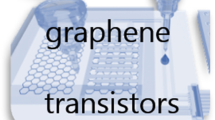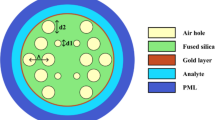Abstract
Extraordinary electrical and optical features of graphene-based materials attract researchers to improve sensing center of different sensors using them. In this research, the effects of sensing molecules on electro-optical features of graphene-based sensors are modeled. The adsorption effect on the Hamiltonian of the system based on tight-binding model is explored, and also the system band structure is investigated analytically. Then, refractive index deviations based on band gap variations are discovered which are used in response modeling of a graphene-based surface plasmon resonance (SPR) sensor.











Similar content being viewed by others
References
Chen X et al. (2013) Nanowire-based gas sensors. Sensors Actuators B Chem 177:178–195
Wang Y, Yeow JTW (2009) A review of carbon nanotubes-based gas sensors. Journal of Sensors 2009:24
Hu P et al. (2010) Carbon nanostructure-based field-effect transistors for label-free chemical/biological sensors. Sensors 10(5):5133–5159
Meshginqalam B et al. (2016) Engineer-able optical properties of trilayer graphene nanoribbon. Phys Scr 91(3):035802
Altanhan T, Kozal B (2012) Impurity effects in graphene. The European Physical Journal B 85(7):1–5
Verma R, Gupta BD, Jha R (2011) Sensitivity enhancement of a surface plasmon resonance based biomolecules sensor using graphene and silicon layers. Sensors Actuators B Chem 160(1):623–631
Kuila T et al. (2011) Recent advances in graphene-based biosensors. Biosensors & Bioelectronics 26(12):4637–4648
Rivera IF et al (2010) Graphene-based ultra-sensitive gas sensors. In 2010 Ieee Sensors. p 1534–1537
Varghese SS et al. (2015) Recent advances in graphene based gas sensors. Sensors Actuators B Chem 218:160–183
Datta S (2005) Quantum transport: atom to transistor. Cambridge University Press, Cambridge
Morris JE, Iniewski K (2013) Graphene, carbon nanotubes, and nanostructures: techniques and applications. Taylor & Francis, London
Serp P, Machado B (2015) Nanostructured carbon materials for catalysis. Royal Society of Chemistry, London
Ahmad A, Mohib-ul Haq M (2014) A study of energy gap, refractive index and electronic polarizability of ternary chalcopyrite semiconductors. Iranian Journal of Physics Research 14(3):89–93
Reddy RR et al. (2008) Correlation between optical electronegativity and refractive index of ternary chalcopyrites, semiconductors, insulators, oxides and alkali halides. Opt Mater 31(2):209–212
Geddes CD (2014) 30 Years of surface plasmon resonance (SPR) for biosensing. Plasmonics 9(4):727–727
Meshginqalam B et al. (2016) Graphene embedded surface plasmon resonance based sensor prediction model. Opt Quant Electron 48(6):1–14
Wu L et al. (2010) Highly sensitive graphene biosensors based on surface plasmon resonance. Opt Express 18(14):14395–14400
Acknowledgments
The authors would like to acknowledge the Faculty of Electrical Engineering, Universiti Teknologi Malaysia for their support and contribution to this study under visiting research program.
Author information
Authors and Affiliations
Corresponding author
Rights and permissions
About this article
Cite this article
Meshginqalam, B., Ahmadi, M.T., Sabatyan, A. et al. The Effect of Molecular Adsorption on Electro-Optical Properties of Graphene-Based Sensors. Plasmonics 12, 1193–1198 (2017). https://doi.org/10.1007/s11468-016-0375-2
Received:
Accepted:
Published:
Issue Date:
DOI: https://doi.org/10.1007/s11468-016-0375-2




